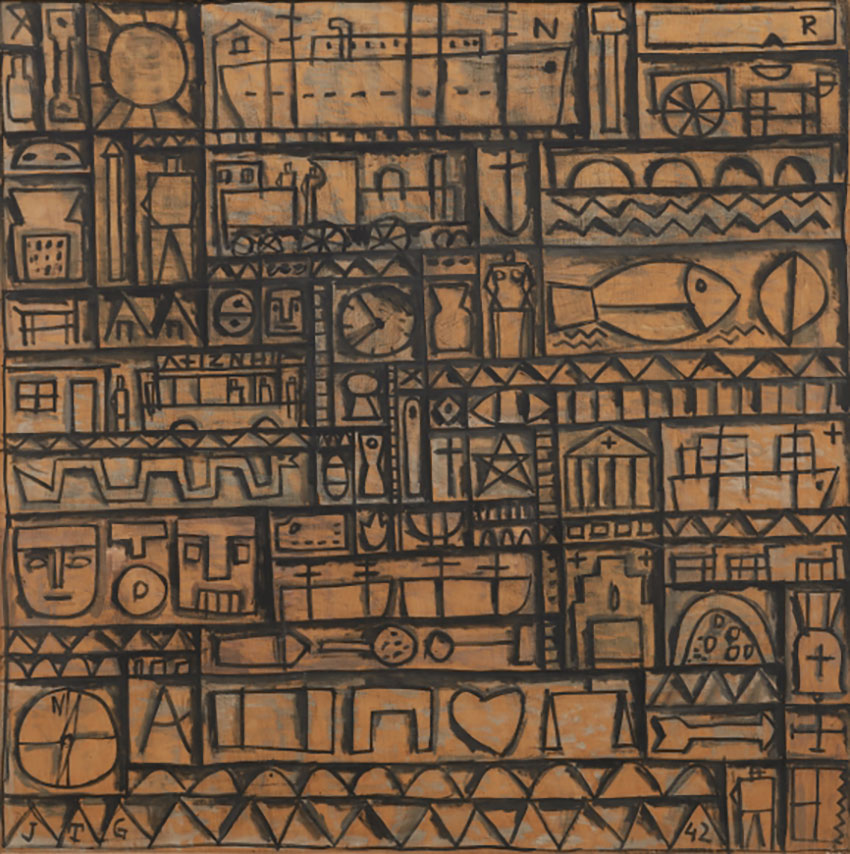The Worlds of Joaquín Torres-García at Acquavella Galleries is a major retrospective of the influential Uruguayan – Spanish modern artist’s work.
Joaquín Torres-García
Torres-García was the most recognized Latin American artist working in Europe at the height of the Modern period. We look back on Modern Art as history now, but Torres-García was there when the boundaries of Modern Art were being defined. He was the Latin American in Picasso’s crowd.
[The only other Latin American artist we know of who was deeply involved in Europe during the Modern Period is Tarsila do Amaral. She brought Modern Art to Brazil and was also inspired by indigenous influences.]
Torres-García was a theorist and teacher. He brought Native American art influences to Europe and brought Modernist influences back to Latin America. In his work, you can see the influence of Mexican Olmec heads, Mayan architecture, and the stone blocks of Incan Machu Picchu.
[Joseph Albers was another important artist and teacher who drew inspiration from Mayan art and architecture.]
Gaudí, Picasso and Miró
Torres-García was born in Montevideo, Uruguay in 1874, but moved to Barcelona, Spain in 1891. There he painted murals in the Palau de la Generalitat, the seat of the Catalan government. He also designed stained glass windows for Antoni Gaudí’s famous Sagrada Familia Cathedral.
Torres-García’s most famous painting style actually resembles the outlines of a stained glass window when you think about it. They are almost storyboards of picture symbols, very much like the Mayan language and symbology that decorates ancient temples in Mexico and Guadalajara.
In Spain, Torres-García met Picasso and his student Joan Miró. Picasso explored indigenous art during his “African Period” from 1906 – 1909. Miró was forever influenced by Torres-García. The relationship is not immediately obvious, but becomes obvious when you compare the two artists’ work. Miró even acknowledged the influence personally.
Torres-García came to New York in 1920 where he ran with Gertrude Vanderbilt Whitney’s American modern art crowd. That group founded the Whitney Museum of American Art.
Cercle et Carré (Circle and Square)
Torres-García founded many art groups and several schools. In Paris he founded the first group of abstract artists Cercle et Carré (Circle and Square). It included many now famous modern artists including Kandinsky, Corbusier, Léger and Mondrian.
The School of the South
In 1934, Torres-García returned to Uruguay where he founded The School of the South and continued to influence the next generation of artists.
Today we mostly see Torres-García’s work in Modern Art museums and auctions. MoMA, the Museum of Modern Art did an exhibition in 2015.
Archetypal symbols are universal, as is the geographic distribution of genius. Like other Latin American artists, the importance of Torres-García was often overlooked, but is increasingly appreciated.
Acquavella Galleries
Acquavella Galleries is one of New York City’s most respected Latin art galleries. It was founded in 1921 by Nicholas Acquavella who was from Naples, Italy.
Acquavella was the dealer who helped American museums build their collections of Italian Renaissance and Baroque art.
In 1960, the son, William Acquavella, joined the gallery and expanded its dealing into Modern Art.
Today the third Acquavella generation (Eleanor, Nicholas and Alexander) has expanded the gallery’s range into Post-War and even Contemporary art.
The Worlds of Joaquín Torres-García
The Worlds of Joaquín Torres-García is on view at Acquavella Galleries in Manhattan’s Upper East Side, Monday – Saturday, from April 12 – May 25, 2018.
The exhibition opens with a reception at the gallery on Wednesday, April 11, 2018 from 6 – 8 pm.
The exhibition of over sixty paintings, sculptures and works on paper from 1896 to 1949 is drawn mostly from the personal collection of the artist’s family. It is the most comprehensive Torres-García gallery exhibition since the 1950s.
Visit Acquavella Galleries
18 East 79th St, New York, NY 10075
(near Madison Avenue)
Upper East Side, Manhattan
(212) 734-6300
Monday – Saturday: 10 am – 5 pm
Subway
(6) to 77th St
The Worlds of Joaquín Torres-García
Influential Uruguayan modern artist
Acquavella Galleries
Upper East Side, Manhattan
Monday – Saturday, 10 am – 5 pm
April 12 – May 25, 2018
For more information, visit www.acquavellagalleries.com

